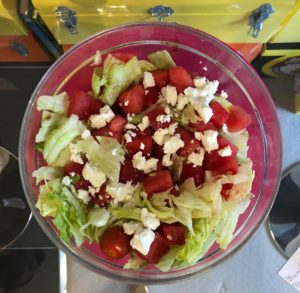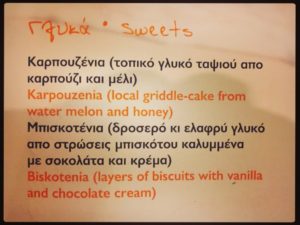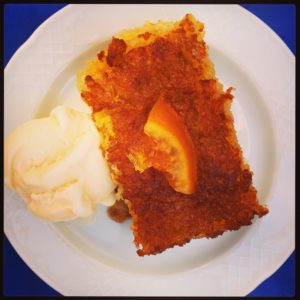6 delicious Greek summer recipes
Hello! I’m finally back in Greece. As much as I enjoy living in London, I sometimes get quite homesick. There are actually two things from my home country that I have missed the most: the delicious food and the summer, hot, sunny and care-free. 2020 has been a very challenging year for most of us. International travel restrictions have taken a toll on many people, including serial travelers like myself. Mindful of the fact that many readers of this blog may not have traveled this year, I would like to give you a taste of the Greek summer and share some of my favorite Greek summer recipes.
Greek summer recipes
If I had to pick one fruit that takes me back to my childhood summers in Greece, this would undoubtedly be the watermelon. During July and August, the hottest months of the year, there would always be a huge bowl with freshly cut watermelon on the table at the end of each and every family meal. The same happened when we dined out; watermelon would always be served there too. In the afternoons, I remember waking up from my nap only to find that my grandmother had prepared a slice of watermelon served with some feta cheese.
Perhaps because it is ubiquitous during the summer in Greece, perhaps because when served in taverns, it is always complimentary, I’d never really thought too much about watermelon. Until I moved to the UK, and started missing the clear-blue skies, the crystalline waters, the heat, and this large oval red-fleshed refreshing fruit.
I recently discovered that watermelon could be far more exciting than I’d previously thought. Let me explain: a few years ago, I went on an island-hopping island to the Cyclades. When I visited the cosmopolitan island of Mykonos, I had my first taste of a watermelon and feta salad. It simply tasted of summer. The sweetness of the watermelon gave such a lift to the saltiness of the feta, the star ingredient of the world-famous Greek salad. Then, when I visited the lesser-known Folegandros, I came across a dessert called karpouzenia or karpouzopita (watermelon pie). Despite its name, this is not a pie (pita means pie in Greek), but a delicious dessert best enjoyed after a heavy meal. Upon my return home, I set out to re-create these two wonderful refreshing dishes.

Mykonos-inspired watermelon and feta salad
Ingredients:
200 grams iceberg lettuce
200 grams watermelon chunks (I tend to buy them already cut)
7-10 cherry tomatoes
100 grams feta cheese, crumbled
Extra-virgin Greek olive oil, for the dressing
Balsamic cream (I prefer the orange and lemon, fig, and pomegranate balsamic creams by Kalamata Papadimitriou), for the dressing
Method:
Place the iceberg lettuce in a large salad bowl. Dress with extra-virgin Greek olive oil and balsamic cream. Add the watermelon chunks and the cherry tomatoes. Crumble the feta cheese and pour it over the salad. Stir gently to integrate the ingredients.

Folegandros-inspired karpouzopita (watermelon pie)
Ingredients:
500 grams watermelon (flesh)
110 grams flour
50 grams extra-virgin Greek olive oil (plus extra to brush the baking pan)
75 grams Greek honey (plus some extra to drizzle over the pie)
1 teaspoon ground cinnamon
2 tablespoons fine semolina
3 tablespoons sesame seeds
Makes 4 (generous) servings.
Method:
If you’ve bought a whole watermelon, remove the rind and cut into small square pieces. Remove the seeds, if any. Put the watermelon pieces into a strainer, and let them strain for about an hour.
In a bowl, combine the watermelon pieces, the flour (sifted), olive oil, honey, cinnamon and 1 tablespoon sesame seeds.
Preheat the oven to 180 C (160 C) fan. Brush a 6×6 in (15×15 cm) square baking pan. Sprinkle with 1 tablespoon semolina and 1 tablespoon sesame seeds.
Spread the watermelon mixture in the baking pan. Sprinkle with the remaining semolina and sesame seeds.
Bake for about an hour. Then, remove from the oven and set aside to cool. Drizzle with some honey.
This is one of the Greek summer recipes included in my e-book ‘Baking Therapy: Healthy Cakes & Bakes: Recipes Inspired By My Travels’, available for FREE for every new subscription (for a LIMITED TIME ONLY).

Crete-inspired savory tomato and feta cheesecake
I’d always thought of cheesecake as a dessert, a wonderful way to finish off a meal, or even a stand-alone dessert. I’ve recently discovered that cheesecakes can be savory too, and they can be an interesting way to kick off a meal. Like sweet cheesecakes, they can be baked or not. Even though I love baking, when it comes to cheesecakes (savory or sweet), I prefer the no-bake recipes. Inspired by the fresh ingredients used in dakos, the refreshing Cretan salad, I recently came up with this brand new recipe for a savory tomato and feta cheesecake.
Ingredients:
For the base:
150 grams Cretan barley rusks (or other rusks)
150 grams butter, melted
1 teaspoon thyme
For the filling:
500 grams cream cheese
200 grams feta (or katiki or mizithra) cheese, crumbled
1 cup Greek yogurt (170 grams)
Zest and juice of 1 lemon
For the topping:
Cherry tomatoes, finely sliced (I used about 15)
Balsamic cream or spray
Method:
To prepare the base, beat the rusks in a blender until finely ground, then pour over the melted butter, and sprinkle the thyme.
For the filling, mix the cream cheese, the crumbled feta cheese, the yogurt, the lemon juice and the lemon zest together (I do this by hand).
Pour the mixture over the base, and refrigerate for at least several hours.
Finally, pour the cherry tomatoes over the filling, drizzle with the balsamic cream (or spray with the balsamic spray), and place the cheesecake back in the fridge until it’s time to serve.
Tips:
To make and serve my cheesecake, I usually use a rectangular glass oven dish. This means that I don’t have to take the cheesecake out until it’s serving time, so I don’t have to worry about the cheesecake not holding its shape. If, however, you’re planning to use a springform pan and want your cheesecake to hold its shape when sliced, I would recommend using gelatine leaves (or sheet) in the recipe. Follow the product instructions; in general, you will need to hydrate the gelatine sheets in ice-cold water for a few minutes, then remove the hydrated gelatine and melt it in a pan at low temperature, before adding it to the cheesecake mixture and mixing well.

Kos inspired sweet tomato and feta cheesecake
The inspiration for this cheesecake recipe came when I visited the island of Kos. Located just 4 miles away from the Turkish coast, this Greek island Kos is a popular destination for European holiday-makers. But, the island has much more than crystal-clear waters to offer. Another reason to visit Kos is for the local cuisine and delicacies: tomato spoon sweet, tomato jam and wine cheese. On my way back home, I had them all packed in my suitcase. Whilst unpacking, looking at these wonderful products, I came up with the idea for a sweet tomato cheesecake. It is a perfect way to showcase the tomato spoon sweet or the tomato jam. For the filling, however, I did not use wine cheese; instead, I used feta and cream cheese.
Spoon sweets are traditional desserts that can be made from most fruit, such as citrus fruits, cherries, figs, quinces, or even tomatoes (technically a fruit). In the past, fruits were preserved in sugar syrup to prolong their season, and this is how spoon sweets were born. Nowadays, they remain a popular dessert, usually served in a teaspoon on a small crystal or porcelain plate, along with a glass of water and/or coffee, as a welcome gesture. A spoon sweet is made with only one type of fruit, although you can also find spoon sweets made with nuts or roses (instead of fruit).
Ingredients:
For the base:
100 grams digestive biscuits
50 grams butter (or coconut butter), melted
1 teaspoon cinnamon
For the filling:
450 grams cream cheese (best to use full-fat)
50 grams feta (or anthotyro) cheese, crumbled
1 cup Greek yogurt (170 grams)
1/4 cup honey (85 grams)
1 teaspoon lime juice
1 teaspoon vanilla extract
For the topping (optional):
I used tomato spoon sweet, but you can use any other spoon sweet, jam/marmalade, or fresh fruit, or even no topping at all (see tip below).
Makes 4 individual cheesecakes.
Method:
To prepare the base, crush or crumble the biscuits, then pour over the melted butter, and sprinkle the cinnamon. Divide the mix into 4 glass tumblers, and refrigerate them for about half an hour, before adding the filling on it.
For the filling, mix the cream cheese, the crumbled feta cheese, the honey, the yogurt, the lime juice and the vanilla extract together (I do this by hand).
Pour the mixture into the tumblers, over the base, and refrigerate them for at least several hours.
Finally, pour the topping over the filling (if using), and place the tumblers back in the fridge until it’s time to serve.
Tip:
Every time I want to showcase a spoon sweet (tomato or other), I prefer making individual cheesecakes, using this recipe. If, however, I’m planning to use jam/marmalade, I prefer making a regular-size cheesecake.
This is one of the Greek summer recipes included in my e-book ‘Baking Therapy: Healthy Cakes & Bakes: Recipes Inspired By My Travels’, available for FREE for every new subscription (for a LIMITED TIME ONLY).

Amorgos-inspired portokalopita (orange pie)
Amorgos is one of my favorite Greek islands. Hora, the capital and one of the main settlements of the island, is a charming inland village built on top of the Mount Profitis Ilias. I remember strolling through its narrow streets where blushing bougainvilleas climb the walls of white-washed houses and blue-domed churches and chapels; their doors and window shutters painted blue, red or green, matching the chairs and tables scattered around the cobblestone alleys. And then I came across Kallisto, an inviting little café-patisserie. I had a slice of portokalopita (orange pie), which was indulgently served with vanilla ice-cream. Despite the name, portokalopita is not a pie, but a syrupy cake. Returning home, I set to re-create Kallisto’s portokalopita. For me, this is one of the ultimate Greek summer recipes.
Ingredients:
175 mls kefir
2 packs of ready rolled filo pastry (approx. 450 grams)
Juice and zest of 3 oranges
4 eggs
250 mls Greek olive oil
1 cup (350 grams) Greek honey for the syrup, and 1/4 cup (75 grams) honey for the main mixture
2 teaspoons vanilla extract
2 tablespoons baking powder
Method:
Let the filo pastry dry (preferably overnight). Once they are dry, cut them into small pieces.
Squeeze and grate the zest of the oranges.
Beat together half of the zest, the eggs, the olive oil, 1/4 cup (75 grams) honey and the vanilla extract.
Mix the baking powder in the kefir, and stir into the egg mixture. Stir the filo pieces into the egg mixture.
Preheat the oven to 180 C (160 C fan). Brush a 25 x 30 cm baking pan. Transfer the mixture into the baking pan.
Bake for 35 minutes, or until golden.
Meanwhile, make the syrup. In a pan, add the squeezed orange juice, the remaining half of the zest, and the remaining honey (350 grams). Bring to the boil, stirring along. Then, simmer for 5 minutes and, then, remove from the heat. Pour the syrup over the pie, and let it stand for a couple of hours, before serving.
This is one of the Greek summer recipes included in my e-book ‘Baking Therapy: Healthy Cakes & Bakes: Recipes Inspired By My Travels’, available for FREE for every new subscription (for a LIMITED TIME ONLY).

Rhodes-inspired fanouropita
Last but not least, I’d like to share a brand new recipe, not published before. Fanouropita is a traditional cake (again not a pie, although pita means pie in Greek) named after Saint Fanourios, patron saint of Rhodes. Fanourios means the one who reveals (fanerono means reveal in Greek), and according to the tradition, Saint Fanourios helps people find their lost belongings or even missing persons. He is commemorated on 27 August. In Rhodes and other places in Greece and Cyprus, believers bake the cake on 26 August; then, the following day, they take it to the church where the cake is blessed and then offered to more believers. Fanouropita, as it is called, is a fasting cake made with 7, 9, or 11 ingredients (always an odd number).
To make it healthier, I have replaced the sugar -traditionally used- with honey, and I have also skipped the final step of sprinting icing sugar over the baked cake.
Ingredients:
540 grams flour, sifted
1 teaspoon baking powder
1/2 teaspoon baking soda
1 teaspoon cinnamon
1/2 teaspoon ground cloves
1/2 teaspoon nutmeg
350 mls Greek olive oil
50 mls Metaxa or Greek sweet wine (such as Vinsanto)
125 grams Greek honey
Juice (200 mls) and zest from 2 oranges
160 grams raisins
Method:
Mix the dry ingredients together.
Mix the wet ingredients together.
Combine the dry with the wet ingredients. Add the orange zest and the raisins.
Preheat the oven to 180 C (160 C fan). Brush a 24 cm (9 in) round cake tin. Transfer the mixture into the tin.
Bake for about an hour, until the cake is deep golden brown and a skewer inserted into the center comes out clean. Set aside for 10 minutes before turning onto a wire rack to cool.
Further reading (and baking):
For more Greek summer recipes, check out my post ‘Healthy cakes & bakes inspired by my travels‘.
Bon Appétit!
Alex
(the Traveling-again-Psychiatrist)
One Comment
Pingback: